Vintage Sheet Music – William Stanley's Bay View Gavotte
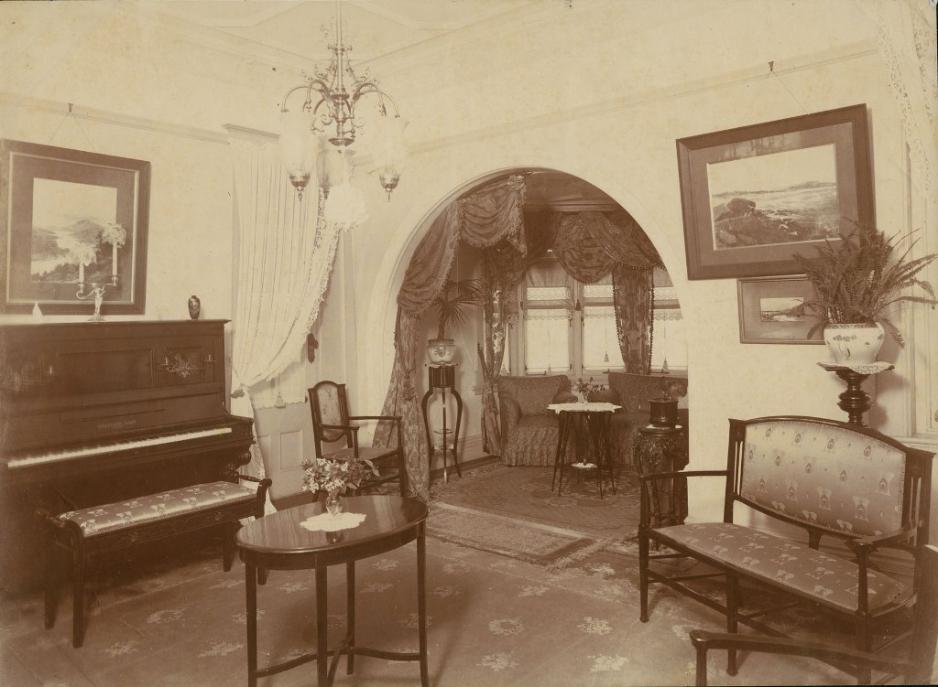
The drawing room at Bangoola, Mosman, 1912 / photographer unknown - Courtesy Caroline Simpson Library & Research Collection, Historic Houses Trust
Vintage Sheet Music – William Stanley's Bay View Gavotte
LITTLE SHIPS OF BAYVIEW.
The little ships of Bayview they are bravely slim and small,
They go out by Barrenjoey, where they shouldn't go at all;
You may watch their bowsprits tossing, where the coastal steamers go
These little ships of Bayview, with their sails as white as snow.
The little ships of Bayview, they come sailing In at night,
With a silver path behind them, and the moon to mark their flight;
There are shaky lights at Newport, and an arch of stars that know
The little ships of Bayview, with their sails as -white us snow.
There are songs across the water, as the little ships go by,
To their anchor-buoys at Bayview, where the sleepy houses lie;
Faint and drowsy nod their anchors, and the stars lean very low,
On the little ships of Bayview, with their sails as white as snow.
-GILBERT MANT.
LITTLE SHIPS OF BAYVIEW. (1925, August 22). The Sydney Morning Herald (NSW : 1842 - 1954), p. 11. Retrieved fromhttp://nla.gov.au/nla.news-article16237249
Many would state that our first songs came out with the first ships as sea shanties, however, there were others aboard, with other forms of music, voices and instruments to play them on for others to dance along to. From earliest days we have had a vast range of musicians and composers, many of whom may have supplemented their income composing and selling music.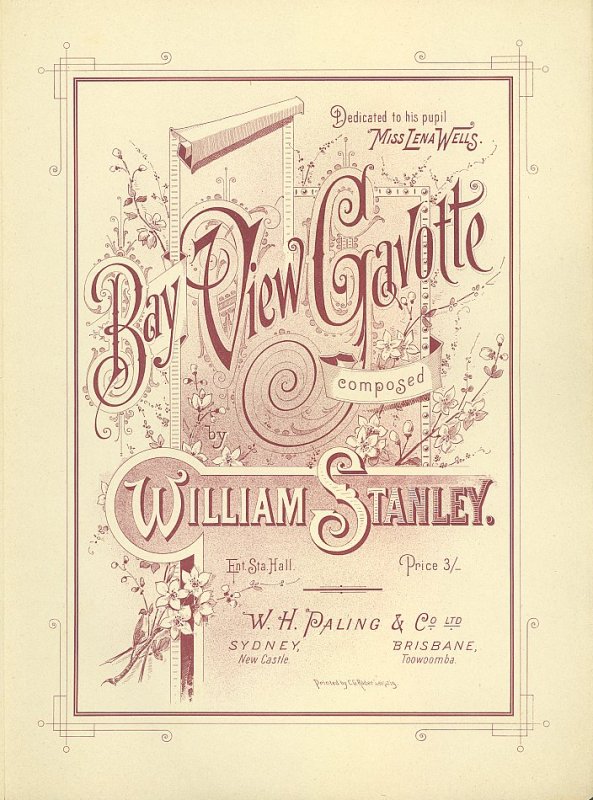 The Victorian era brought innovative forms of dance to add to traditional waltzes, including the Gavotte, which originated as a French folk dance, taking its name from the Gavot people of the Pays de Gap region of Dauphiné where this dance was first danced.
The Victorian era brought innovative forms of dance to add to traditional waltzes, including the Gavotte, which originated as a French folk dance, taking its name from the Gavot people of the Pays de Gap region of Dauphiné where this dance was first danced.
Experts in the field of collecting Sheet Music state that more rare or older documents attract higher figures, as do those autographed by their composers or their performers, many of whom are still popular. The Cover Illustration will fetch more attention too, especially among archivists or those who collect these for their historic value.
People use Sheet Music as decorations for hearth and home, framing them or creating a collage to brighten up walls. They are, of course, the record referred to when musicians interpret the music of long ago in order to perform.
Music was often dedicated to a certain person, usually because they were a patron and supporting the artist financially, or the artist hoped they would. For example, Nadezhda Filaretovna von Meck, a Russian business woman who became an influential patron of the arts, especially music, is best known today for her artistic relationship with Pyotr Ilyich Tchaikovsky, supporting him financially for thirteen years, so that he could devote himself full-time to composition. Tchaikovsky dedicated his Symphony No. 4 in F minor to her. She also gave financial support to several other musicians, including Nikolai Rubinstein and Claude Debussy.
In times when young ladies were being educated at home, one of the 'accomplishments' required to be part of 'society' was that of playing the piano. The social rounds were composed of 'at homes' where tea and cakes may be served but also, where the piano or other forms of musical instruments were played. A constant stream of music, new music, thus had an audience and a market.
Just as modern musicians find it's a 'long and hard road to the top if you want to rock and roll' their counterparts from earlier days did not find it any easier either. How do you generate a good income? Then, as now, you write what you hope will be a 'hit':
New Music. We have received from Messrs., Paling and Company the following musical compositions: " A Proposal," a song, by J. Ivory. The 'music is in F major. lb is a love ditty, and both the words and the music breathe tenderness and passion. The poor fellow whose feelings the song represents seems to be in doubt whether his Love will say no or yes when the all-important question is put to her but the composer, in the accompaniment, cheers him with a faint and shadowy musical apparition of coming wedding bells. "Her Lad Across the Sea," song, words by G. Hubi Newcombe, music by Milton Wellings. We have in a former issue expressed approval of this song, and still hold the same opinion. "Until the Eventide," song, by Frank E. Down, words by E. J. Basset-Hull. The music is beautifully printed by Roder, of Leipzig. The letterpress contains a few errors such as might be expected in the work of a foreign scribe, as mingels for mingles, and by for ly, &c.¿ but* these the English singer can easily avoid. The music is romantic, musicianly, and very creditable to the composer's' genius.' It is written in D flat major. " The Sentinel," a song, composed by Fred., Burry, and written by J. Sinclair Tayler. This is a military love song. The scenery described in it forcibly reminds the reader of the words of that remarkable passage, concluding the' eighth book of the -, "Iliad" in which Hector, is represented as making provision for the safety of Troy during the night'. "A thousand fires blazed on the plain, and by each sat fifty men, while the steeds; eating white barley and oats, standing by the chariots, awaited beautiful throned Aurora." So Mr. Tayler says : "As silence reigns around I sentry keep, my weary comrades strew the ground asleep, in camp! fire's glow." The sentinel, however, dreamily and fondly muses on his sweetheart, whilst he watches over the safety of his comrades, and the composer gives him an opportunity of expressing his feelings by introducing into the song a neat little love waltz. The music is written in G major, and the song altogether is pretty, and rather above the common run of love lyrics. " The Boys' Waltz," composed by Ernest E. Trueman, and “The Patricia Waltz," composed by F. E. Burry, and dedicated to Lady Carrington, are pleasant pieces for the drawing-room, and well adapted to occupy a fairly good position amongst the swarm of waltzes which issue from the press almost every day in the year. New Music. (1895, June 1). Australian Town and Country Journal (Sydney, NSW : 1870 - 1907), p. 37. Retrieved fromhttp://nla.gov.au/nla.news-article71230518
Collecting Sheet Music is more interesting if you know a little about the provenance of the piece and the people behind it – that way, if it’s not valuable due to its rarity, it has other values not restricted to Mammon which ultimately are where true worth actually resides.
One that caught our interest as it reminded us of the beautiful place in Pittwater called ‘Bayview’ once ‘Bay View’, is a gavotte written and dedicated to a student. The title actually refers to a home overlooking Glebe Point, George Well’s ‘Bayview’ and the student was one of his many children with wife Sarah (nee Goddard).
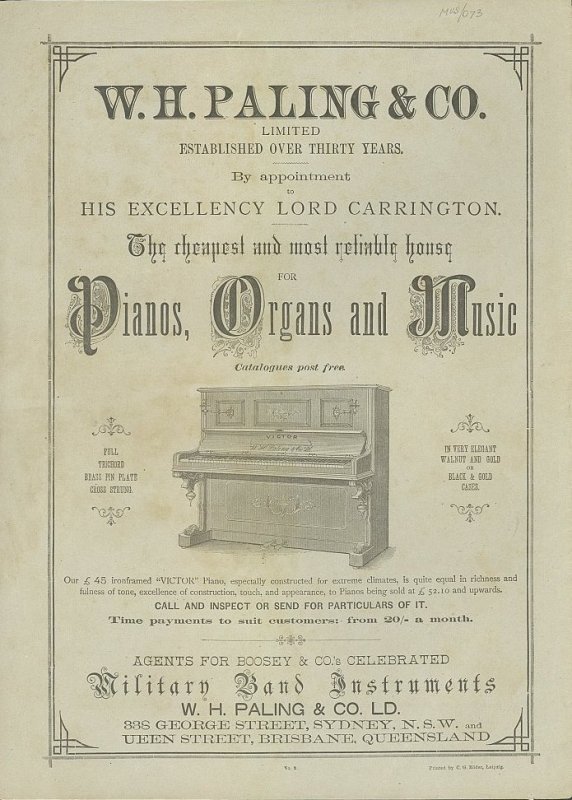 The Gavotte has on its back Cover a W H Paling reference to Lord Carrington, Governor of New South Wales from December 11th 1885 until November 1890, indicating the time the work was published in. The student the work is dedicated to is Lena Wells, fourth and youngest daughter of George and Sarah Wells, born December 11th 1877, who could have only been 8 or 13 when this work was produced.
The Gavotte has on its back Cover a W H Paling reference to Lord Carrington, Governor of New South Wales from December 11th 1885 until November 1890, indicating the time the work was published in. The student the work is dedicated to is Lena Wells, fourth and youngest daughter of George and Sarah Wells, born December 11th 1877, who could have only been 8 or 13 when this work was produced.
George Wells, a Glebe Alderman from 1878 to 1883, was born 7th of August 1832 at Great Yarmouth, Norfolk, England, son of George Wells. At ten years of age in 1842, Mr. Wells set out on the life of a seafarer for nine years, settling in Sydney in 1851. He rented premises at May Street Ultimo, conducted a produce business in Market Street and acquired a livestock auctioneer’s licence, before moving to the Forest Lodge Ward of Glebe in the late 1870's. Trading as George Wells & Matthews, commission agents, at the Corn Exchange from 1887 to 1901, by 1909 he was the oldest livestock auctioneer in NSW. Mr. Wells had been appointed a JP and magistrate in 1878. He married Sarah Goddard at Scots Church Sydney on 29 October 1855.
Respected in the Glebe area Wells, using his skills as an auctioneer, chaired parliamentary campaign meetings for Michael Chapman, Percy Lucas and George Wigram Allen. New South Wales Births, Deaths and Marriage records indicate they had between 14 and 16 children, so even they lost some to childhood illnesses, the means to support a large household and a home full of dancing children is easily imagined.
The creator of the ‘Bay View’ Gavotte was William Stanley, Professor of music, pianist, organist and clearly, composer:
THE OLDEST PIANIST IN AUSTRALIA.
It is with regret that we learn of the death of Mr. William Stanley, who was born at Windsor Castle on May 29, 1820. He was a son of the late organist of St Georges Chapel, Royal Windsor, and was educated at the chapel where he remained until 1836. He started his musical career at the very early age of six years, and at the age of 10 he played solos at Rochester, in Kent, and performed at Windsor Castle before Queen Adelaide, both of these performances being his own compositions. He was also a singer at the funeral of the late King George IV.
Shortly after this Mr. Stanley joined the army, having enlisted with the 80th Regiment under the command of Colonel Pitt, of Chatham. In this regiment he served for about five years, after which he took his passage to Australia in charge of a vessel sent hereby the home Government with prisoners on board, which arrived here about the year 1837.
His first performance in Australia was at the opening of the original "Victoria Theatre" in the presence of the Governor at that time (Sir George Gipps), after which Mr. Stanley acted as accompanist to the late Madam Sara Flower, the noted contralto, Miska Hansa the celebrated violinist, and Madam Anna Bishop the English soprano. He also played duos with Bolanger, the French pianist.
Mr. Stanley's first appointment as an organist was at St John's, Parramatta, during the time of the Rev. H. H. Hobart, where he remained for eight years.
Later on Mr. Stanley was appointed organist to the Sydney Choral Association, and held the position of bandmaster to the first volunteer artillery band. He was also first lieutenant to the South Sydney Volunteers, for which corps he organised a band on his own account. He also held positions as organist to the following churches, viz.:—St. Andrew's Cathedral for 16 years, St. Barnabas' for seven years, and Christ Church, Sydney, for 12 years.
Amongst some of Mr Stanley's many excellent compositions are "Variations to God Save the King," an arrangement he wrote at the age of 8½ years; two marches, one in C minor and the other in E flat, written at 10 years of age; an oratorio, "David and the Philistines;" march and preludes to Handel's "Israel in Egypt;" numbers of church anthems and chants, and over 100 various other pieces.
In addition to this he wrote a Jubilee Ode to celebrate the Jubilee of our late Queen Victoria, words by the late Edward Baly. In 1879-80, at the musical festival at the International Exhibition here, Mr. Stanley conducted "The Messiah" and "Israel in Egypt" before an audience of 10,000 people; and on the death of the late Charles Packer that composer's sacred cantata, "The Crown of Thorns," was completed by the late Mr. William Stanley.
Mr. Stanley also held a high position in the Masonic Lodge. Mr. Stanley, who died at Petersham last week, was buried at Rookwood. He leaves a family of grown-up children of three sons and two daughters.THE OLDEST PIANIST IN AUSTRALIA. (1902, September 18).The Sydney Morning Herald (NSW : 1842 - 1954), p. 8. Retrieved fromhttp://nla.gov.au/nla.news-article14510138
Mr Stanley's first public recital did not overawe this critic:
....A Mr. Stanley played one of Herz's concertos on the piano forte fairly, but nothing more.....DOMESTIC INTELLIGENCE. (1838, October 22). The Sydney Herald (NSW : 1831 - 1842), p. 2. Retrieved from http://nla.gov.au/nla.news-article12859991
But he did go on to produce more works among the many who propagated what Dr. Graham refers to as 'Colonial Music' in his comprehensive 2011 thesis: 'TOWARD A GENERAL HISTORY OF AUSTRALIAN MUSICAL COMPOSITION - FIRST NATIONAL MUSIC 1788-c.1860.'
THE THOMASINE QUADRILLES.-Mr. William Stanley, whose name is well known in connection with musical art in Sydney, has composed a set of dashing quadrilles, bearing the above title, anddedicated to Miss Korff. They have all tho elements of popularity, and it is therefore probable the Thomasine quadrilles will be well patronised. ADELAIDE. (1867, December 21).The Sydney Morning Herald(NSW : 1842 - 1954), p. 13. Retrieved fromhttp://nla.gov.au/nla.news-article28608354
THE MOSS-ROSE WALTZES .- Mr. William Stanley, a very Chester at musical composition, is again in the field with another set of waltzes, bearing the above title. To enter into an elaborate criticism on dance music is next to impossible; as regards waltzes there is rarely a middle state - they are either good or bad. Those before us are written in the key of B flat, in three-four time (the latter will scarcely be regarded as a piece of information), are divided into three parts, and we venture to assert that when performed they will be pronounced lively and good. They are published by Messrs. Elvy and Co. No title. (1870, March 15). The Sydney Morning Herald (NSW : 1842 - 1954), p. 5. Retrieved fromhttp://nla.gov.au/nla.news-article13202148
We have received two pieces of music of more than ordinary excellence, by local composers. One is the "Sydney International Exhibition Grand March, "for the pianoforte, organ, military band, and orchestra, by William Stanley; and the other a promenade rondo for the pianoforte, by Alexander Rea. The march is a spirited composition, commencing in the key of D major with a trio in G, and reverting, in accordance with musical rule, to its original air in the coda. The composition is artistic, and likely to be popular. It is well printed by John Sands, and copyright. The rondo by Mr. Rea is entitled "The Promenade," and is in the key of G major. The air is classic, the strains are lively, and the piece is full of beautiful harmonies. It ought to find many admirers among musical students. It consists of ten pages, exclusive of the title andcover, is beautifully printed, and published by Messrs. Elvy and Co., and sold by all music-sellers. NEWS OF THE DAY. (1879, June 24). The Sydney Morning Herald (NSW : 1842 - 1954), p. 5. Retrieved fromhttp://nla.gov.au/nla.news-article13437192
Sacred Choral Association. The Sacred Choral Association gave the third concert of the current season in the Protestant Hall last night. There was a large audience, which, judging from the applause that followed the rendition of each number on the programme, was a very appreciative one. The concert commenced with an additional solo and chorus, composed by Mr. W. Stanley since the performance of his oratorio-, 'David and the Philistines,' in last April, and which are to be incorporated with the Oratorio. The solo and chorus are exceedingly creditable to the composer b originality and general musical ability. This was followed by Handel's' Judas Maccabeus,' in which the principals were Miss Shipway, Madame Merz, Mr. F. P. Brewer, and Mr. F. J. Hallewell. There was a numerous chorus, in which the voices were tolerably fairly balanced. The duets allowed to the lady principals were sung with sweetness and skill, he voices blending harmoniously together. Madame Men was in good voice, and sang her solos very effectively. Miss Shipway's fine voice was heard to great advantage in the little that she had to do, which was the rendition of a short and simple aria, and which furnished no ground whatever as a basis for a critical estimate of her ability to interpret other portions of Handel's music. A word of praise is due to Mr. Brewer for his spirited rendition of several arias, and, as for Mr. Hallewell, it would be more difficult for him to sing badly than to sing well. Whenever, therefore, it is stated that he sang, it may be concluded that he sang well. The full chorus was efficient. The boys Introduced to sing 'See the conquering hero comes ' near the close of the work, were not so well versed in their parts as they might have been ; bat, nevertheless, the number was fairly interpreted. Mr. Albert Fisher conducted, Mr. W. J. Sharpe presided at the organ, and Mr. W. Stanley acted as pianist. On the whole, a very fair rendition, both of Mr. Stanley's addition to his oratorio and of Handel's work, was given by the association, and it was very creditable to all concerned. Sacred Choral Association. (1884, July 9). Evening News(Sydney, NSW : 1869 - 1931), p. 3. Retrieved fromhttp://nla.gov.au/nla.news-article107265372
We have a collection of Sheet Music, collected more for use then for what it may be worth, but some among these songbooks are rare and not easily found items nowadays, as well as a few autographed versions. Their condition, through use, would not fetch substantial prices in any collector's market but is worth noting that if you have some old rare pieces they could be worth a lot more then you think!
References:
Bay View gavotte [music] / composed by William Stanley: "Dedicated to his pupil Miss Lena Wells". Plate no.: P.92 Co. Printer C. Roder, Leipzig Item No.: 76011, courtesy National Library of Australia. Also available in an electronic version via the Internet at:http://nla.gov.au/nla.mus-an5406312
Graeme Skinner. The University of Sydney. TOWARD A GENERAL HISTORY OF AUSTRALIAN MUSICAL COMPOSITION - FIRST NATIONAL MUSIC 1788-c.1860. A thesis submitted in fulfilment of requirements for the degree of Doctor of Philosophy Sydney Conservatorium of Music. 2011. Available online, retrieved from: ses.library.usyd.edu.au/bitstream/2123/7264/1/ga-skinner-2011-thesis.pdf - 6.52 MB
Graeme Skinner (University of Sydney), A biographical register of Australian colonial musical personnel–S, Australharmony (an online resource toward the history of music and musicians in colonial and early Federation Australia) :sydney.edu.au/paradisec/australharmony/register-S.php
Sydney Aldermen website: www.sydneyaldermen.com.au
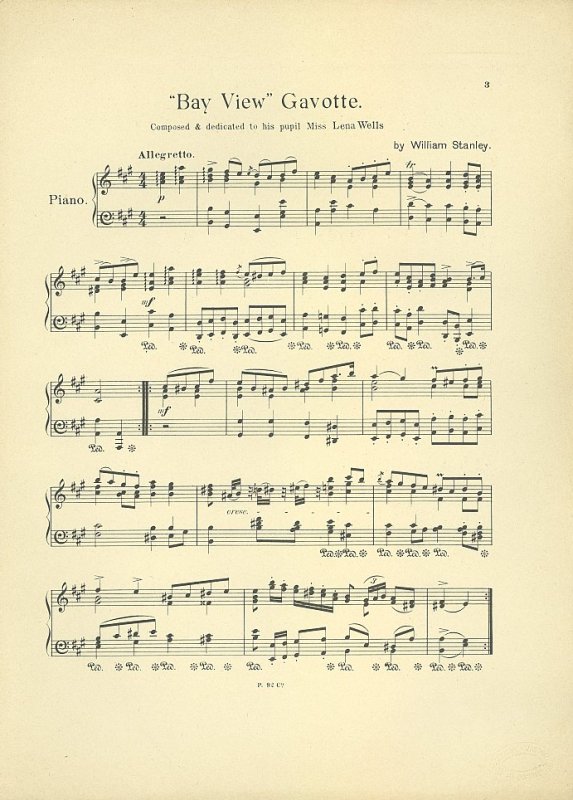
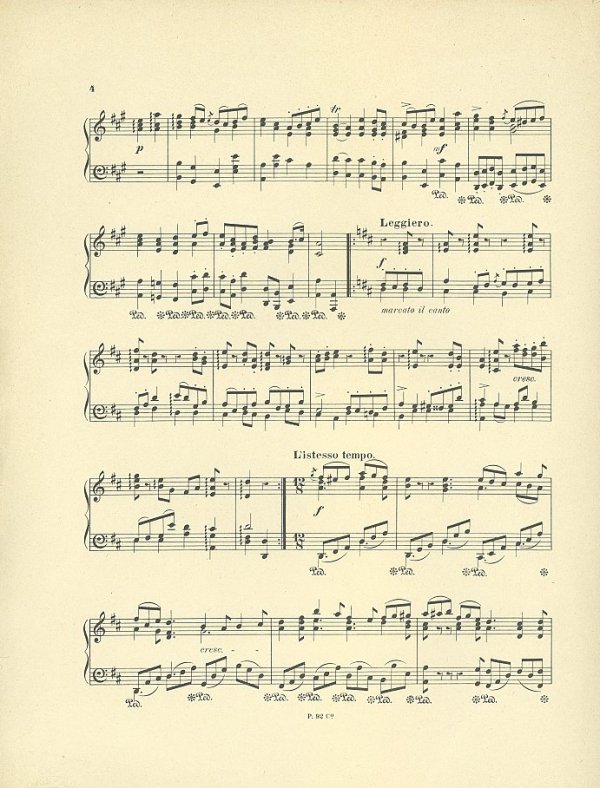
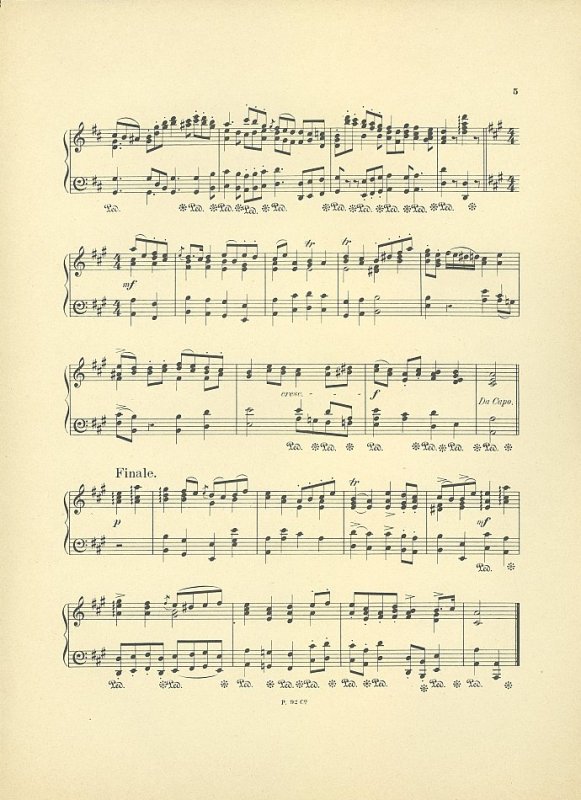
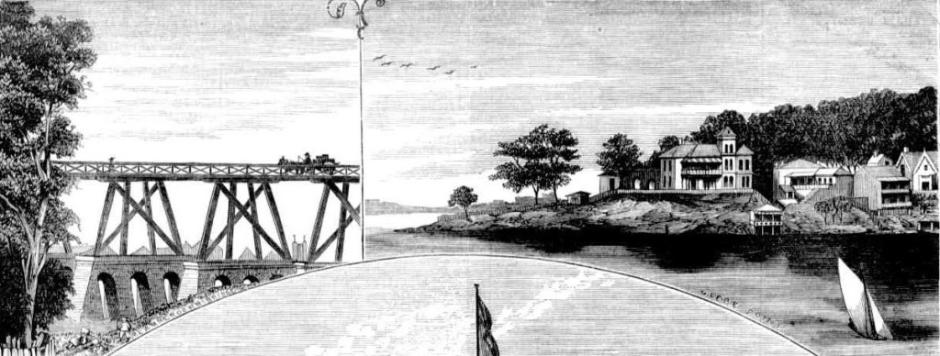
Above: Glebe Point 1880 (section from Illustration): Glebe, Sydney, N.S.W. (1880, July 24). Australian Town and Country Journal (Sydney, NSW : 1870 - 1907), p. 24. Retrieved from http://nla.gov.au/nla.news-article70946079
Extras:
gavotte, lively peasants’ kissing dance that became fashionable at the 17th- and 18th-century courts of France and England. Supposedly originated by the natives of Gap (Gavots) in the southeastern French province of Dauphiné, the gavotte was danced in royal ballrooms as a round with skipping steps adapted from the branle. Couples concluded improvised duet performances by kissing their partners. Later the dance developed more formal figures, and flowers were exchanged instead of kisses. At the French court in the 18th century, the gavotte was at first stately and later more ornate; its slow walking steps were in 4/4 time, with upbeats on beats 3 and 4.
In a suite the gavotte appears among the optional subordinate movements called galanteries. Its three-part composition is written in its early lusty 2/2 rhythm but retains the later two upbeats; its second section is a musette, a pastoral air in which a drone bass runs throughout.
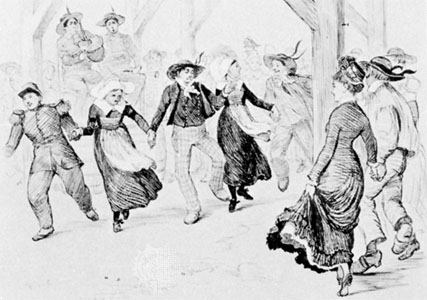 The gavotte is first described in the late 16th century, as a suite or miscellany of double branles, danced in a line or circle to music in duple time, "with little springs in the manner of the Haut Barrois" branle, with some of the dance steps "divided" with figures borrowed from the galliard. The basic step pattern is the same as for the common or double branle, with the line of dancers moving alternately to the left and right with a double à gauche and double à droite. In the double branle, each of these composite steps consists of four components: a pied largi (firm outward step), pied approche (the other foot drawn near but not quite up to the first), another pied largi, a pied joint (following foot drawn against the leading one). The basic gavotte steps differ as follows: in the initial double à gauche a skip (petit saut) is inserted after each of the four components; the second pied largi is replaced by a marque pied croisé (the following, right foot crossed over the left and with the toe contacting the floor); the final pied approche is replaced by a grève croisée (the right foot crosses over the left and is raised in the air). The double à droite begins now with a pieds joints and petit saut, followed by two quick steps, a marque pied gauche croisé and marque pied droit croisé, during beat two, a grève droit croisée and petit saut on beat three, and concluding on the last beat with pieds joints and a capriole (leap into the air with entrechat).
The gavotte is first described in the late 16th century, as a suite or miscellany of double branles, danced in a line or circle to music in duple time, "with little springs in the manner of the Haut Barrois" branle, with some of the dance steps "divided" with figures borrowed from the galliard. The basic step pattern is the same as for the common or double branle, with the line of dancers moving alternately to the left and right with a double à gauche and double à droite. In the double branle, each of these composite steps consists of four components: a pied largi (firm outward step), pied approche (the other foot drawn near but not quite up to the first), another pied largi, a pied joint (following foot drawn against the leading one). The basic gavotte steps differ as follows: in the initial double à gauche a skip (petit saut) is inserted after each of the four components; the second pied largi is replaced by a marque pied croisé (the following, right foot crossed over the left and with the toe contacting the floor); the final pied approche is replaced by a grève croisée (the right foot crosses over the left and is raised in the air). The double à droite begins now with a pieds joints and petit saut, followed by two quick steps, a marque pied gauche croisé and marque pied droit croisé, during beat two, a grève droit croisée and petit saut on beat three, and concluding on the last beat with pieds joints and a capriole (leap into the air with entrechat).
The gavotte became popular in the court of Louis XIV where Jean-Baptiste Lully was the leading court composer. Consequently several other composers of the Baroque period incorporated the dance as one of many optional additions to the standard instrumental suite of the era. The examples in suites and partitas by Johann Sebastian Bach are best known. When present in the Baroque suite, the gavotte is often played after the sarabande and before the gigue, along with other optional dances such as the minuet, bourrée, rigaudon, and passepied.
Later composers, particularly in the 19th century, wrote gavottes that began like the 16th-century gavotte on the downbeat rather than on the half-measure upbeat. The famous Gavotte in D by Gossec is such an example, as is the Gavotte in Massenet's Manon. A gavotte also occurs in the second act of The Gondoliers by Gilbert and Sullivan and the Finale of the First Act of Ruddigore also by Gilbert and Sullivan. Sergei Prokofiev employs a gavotte instead of a minuet in his "Classical" Symphony. Gavotte. (2014, October 21). In Wikipedia, The Free Encyclopedia. Retrieved from http://en.wikipedia.org/w/index.php?title=Gavotte&oldid=630536983
WELLS.—December 11, at her residence, 601 George-street, the wife of G. Wells, of a daughter. Family Notices. (1877, December 17). The Sydney Morning Herald (NSW : 1842 - 1954), p. 1. Retrieved from http://nla.gov.au/nla.news-article28395406
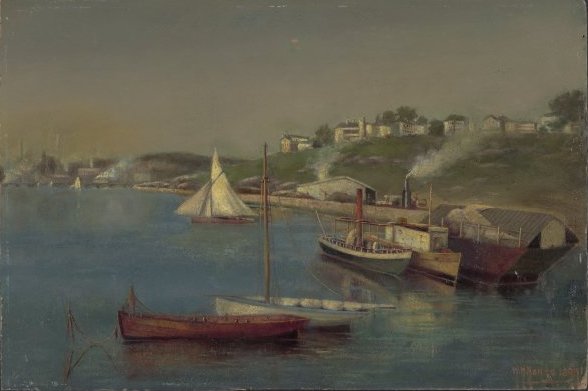
The golden glow of evening [picture] : Glebe Point from Rosella [i.e. Rozelle] Bay, Sydney Harbour / W.H. Howes. Date 1897. Exhibited: "Sydney by Ferry", Museum of Sydney, April - August 2002. nla.pic-an2291520, courtesy National Library of Australia
BURGLARY AT THE GLEBE. Arthur Joseph Black and Charles Norman, two young men, were placed upon their trial at the quarter sessions yesterday afternoon on an Indictment charging them with having broken into the dwelling of George John Wells, and stolen a quantity of plate, harness, and other articles. On the night of March 12 Mr. Wells's residence at Glebe Point was visited by burglars, and the property mentioned stolen. The accused were subsequently arrested, and identified by Mrs. Powell, a resident or Sussex-street, as the persons who had left a portion of the stolen property at her house. The accused were found guilty, and remanded for sentence.BURGLARY AT THE GLEBE. (1898, April 23). Evening News(Sydney, NSW : 1869 - 1931), p. 3. Retrieved fromhttp://nla.gov.au/nla.news-article109649364
Glebe Municipal Elections. Touching the forthcoming municipal elections for the Glebe, and in connection with the facts published in this journal the other day, it appears that there are to be at least three candidates for Outer Ward Mr. Stanley Cole, Mr. John Macnamarra, and the retiring alderman, Mr. S. Duncan. Mr. Cole, it appears, has been in the field for some, time past, and his friends have assured, him of strong support. For Forest Lodge Ward, Mr. A. G. Wells, the well-known produce merchant, and son of a former local alderman, is in the field, having publicly .announced himself and issued a circular. Glebe Municipal Elections. (1895, January 14). Evening News(Sydney, NSW : 1869 - 1931), p. 6. Retrieved from http://nla.gov.au/nla.news-article108073910
Glebe, Sydney, N.S.W.
SINCE the year 1859, when Glebe was declared to bean independent municipality, to be governed by a council chosen from its residents, a complete change has occurred in its appearance and importance. At that time the houses were few and far between, and the population not very numerous. The greater portion of the land was covered by scrub and wattle trees, occupied by numerous camps of blacks, the roads were wretchedly formed, and the lower part of the township was occupied by an impassable swamp. Under the fostering care of its aldermen and councillors it has rapidly developed into one of the most populous and fashionable suburbs of Sydney, and as its distance is only two miles from the metropolis, and the character of its scenery highly picturesque, its streets well paved and in good order, and its situation high, dry, and healthy, it will no doubt keep up its reputation as one of the most desirable places of residence for business men and others who wish to spend their leisure time away from the noise and bustle of the city. Sir George Wigram Allen was the first mayor appointed under the Act, and his popularity was so great that he was re-elected mayor for 20 consecutive years, until he was obliged to resign the position owing to the arduous nature of his duties in the Assembly. To this gentleman and to Alderman Thornley, who was elected at the first council meeting, and who is still a member, the progress which has been made is mainly attributable. The Blackwattle Swamp has been filled up by dredgings from the bay and surplus rubbish from Pyrmont and other quarries, and the soil is now being formed from street sweepings, &c., and it is intended to be shortly opened as a public park, having been granted for the use of the public by the Government. About 40 acres of land in the borough, and a large portion of land in the outer Glebe were granted to the church and school estate ; and, as most of the land is now built upon, the rents add considerably to the revenue of the church. According the last census returns the population numbered 5714, and the value of the property for rateable purposes was £469,000 ; there were 21 hotels and 15schools, and about 10 miles of streets. Since then there has been a considerable increase in the number of houses, and the population has about doubled.
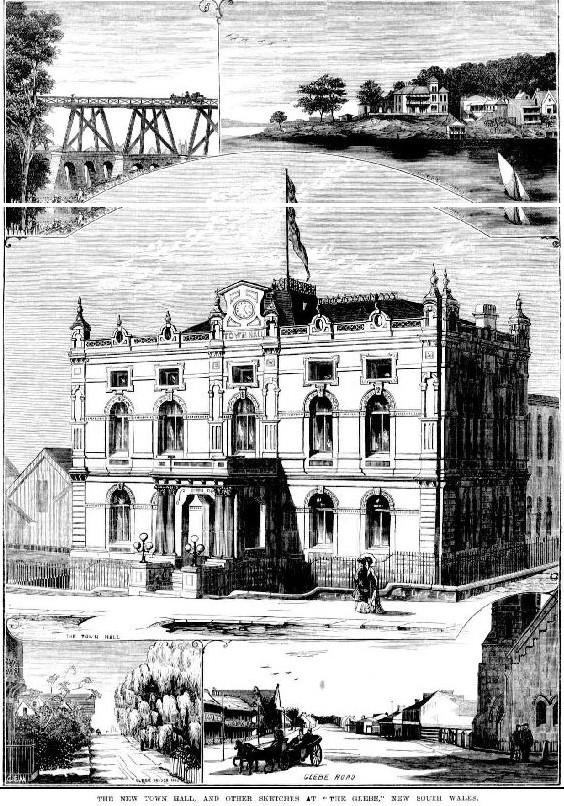 The present representatives in the town councilconsist of the Mayor, T. J. Dunn, Esq., and Aldermen T. Wearne, C. Field, H. Turner, J. Graham, M. Chapman, W. Bull, M. Carey, G. Wells, A. Thornley, sen., P. C. Lucas, and J. P. Walker. The council clerk and treasurer is Mr. D. J. O'Connor. The municipality is represented in the Assembly by the Hon. Sir George Wigram Allen, Speaker of the House. Glebe is divided from the neighbouring borough by the Orphan Creek, over which is built a substantial structure called the Camperdown Bridge. The two main arteries are Glebe-road and Bridge-road, both of them being long, wide, straight, well-paved streets. A wharf is now being formed at the extreme end of Glebe-road, where the ferry crosses over to Balmain. The ferry at Glebe Point is in charge of a man named Suggett, who has lived there for the past 30 years, and brought up a numerous family in the ruins of an old boat, named the Noah's Ark, on the edge of the bay. Suggett boasts that he has never paid any rent, rates, or taxes, or bought any fuel, and he never in-tends to do so, and defies the council or anyone else to remove him from his position. There are several handsome rows of houses, and pretty villas are springing up in all directions on the borders of the creek and the sides of the bay. There are also several important manufactories carried on in the neighbourhood, and several of the Sydney banks have branch establishments here. The Sydney Tramway and Omnibus Company, who have stables in the Glebe, run their conveyances to and from the city every few minutes.
The present representatives in the town councilconsist of the Mayor, T. J. Dunn, Esq., and Aldermen T. Wearne, C. Field, H. Turner, J. Graham, M. Chapman, W. Bull, M. Carey, G. Wells, A. Thornley, sen., P. C. Lucas, and J. P. Walker. The council clerk and treasurer is Mr. D. J. O'Connor. The municipality is represented in the Assembly by the Hon. Sir George Wigram Allen, Speaker of the House. Glebe is divided from the neighbouring borough by the Orphan Creek, over which is built a substantial structure called the Camperdown Bridge. The two main arteries are Glebe-road and Bridge-road, both of them being long, wide, straight, well-paved streets. A wharf is now being formed at the extreme end of Glebe-road, where the ferry crosses over to Balmain. The ferry at Glebe Point is in charge of a man named Suggett, who has lived there for the past 30 years, and brought up a numerous family in the ruins of an old boat, named the Noah's Ark, on the edge of the bay. Suggett boasts that he has never paid any rent, rates, or taxes, or bought any fuel, and he never in-tends to do so, and defies the council or anyone else to remove him from his position. There are several handsome rows of houses, and pretty villas are springing up in all directions on the borders of the creek and the sides of the bay. There are also several important manufactories carried on in the neighbourhood, and several of the Sydney banks have branch establishments here. The Sydney Tramway and Omnibus Company, who have stables in the Glebe, run their conveyances to and from the city every few minutes.
During the last six months 100 new houses have been erected in the borough, and the rates during the past year have increased by £1000.
One of the principal wants of the borough for some time past has been a large hall for concerts and meetings, and also new offices for the transaction of the municipal business ; and in order to meet this requirement it was decided at a council meeting, held last year, to call for tenders for the erection of a Town Hall. The successful tenderer was Mr. Ambrose Thornley, jun., architect, York-street, Sydney, and the work was at once commenced by the well-known contractors Messrs. Sanbrook and Sons, who pushed forward their operations so vigorously, that the council were able to hold their usual monthly meeting in Marchlast, in the new building, and it was formally opened by the Mayor on the 7th of May, its inauguration being celebrated by a banquet, to which all the corporate officers and principal inhabit-ants were invited. The town-hall is built on an elevated site, in the very heart of the borough, with frontages to St. John's-road and Mount Vernon and Lodge streets. The architecture is of the Italian
order, the principal front to St. John's-road being divided into three bays, by means of quoins, &c., and the central figure is a bold porch or portico, approached by a flight of steps, which adds greatly to the general appearance of the design. This front is well relieved by means of openings, which are so arranged as to give a light and chaste appearance to the general elevation. Each bay is divided by four of these openings, surmounted by two square pivot lights, inserted for a twofold purpose, viz., as a relief to the upper portion of the design, and to act as a means for the ventilation of the concert hall, — the whole being surmounted by a bold cornice, bracketed, &c., and perforated balustrading, finished by means of chaste terminals. What will at once catch the eye of the spectators is the treatment of the central portion of the façade, from the portico upwards, which is arranged in the upper portion to receive a clock — a very liberal gift bestowed upon the borough by the ex-mayor, the Honorable Sir George Wigram Allen. Upon entering by the main door into a hall 12ft wide, we find upon our right the clerk's office and council rooms, the dimensions of which are 25ft6in x 16ft 6in, and 25ft 3in x 16ft 5in respectively, and at the rear of the latter are the mayor's reception and private rooms, 12ft x 14ft, and 17ft x 12ft respectively. On the left of the hall is the reading room, 16ft 6in x 23ft, and the library 16ft 5in x25ft 3in. A large number of valuable books has just been presented by Messrs. Seymour and Thornley as a nucleus to the library about to be formed. At the rear of these is the room to be occupied by the inspector of nuisances and the foreman of works, with a spare room adjoining. These rooms, which occupy the whole of the ground floor, are lofty and well ventilated by means of air flues; the fittings are of cedar, highly polished, and each room contains a fireplace, register grate, and marble mantelpiece. Ascending from the ground floor by means of a substantial staircase, highly finished with massive carved newels and neatly turned and carved balusters, we reach the concert or public hall, one of the most important in the edifice.
The area of this hall is about 65ft by 35ft, and it is divided into bays, by means of massive piers 4ft wide, relieved by bold champers, and a floral design in incised work sunk in the pilaster. Surmounting these piers is a neat plaster cornice running round the room, from which springs a bold cove of plaster, finishing on all sides to a moulding of cedar, enclosing a ceiling of wood, divided into panels by a series of cedar moulds, the panels being filled in with lathes 4in wide, of cedar and pine alternated, which are highly varnished, and give a most elegant appearance to the whole. The colouring of the walls and cove is a pale peach, and the cornice and piers white, which together form an admirable contrast to that of the ceiling, and produce a very pretty effect. This room is well ventilated, by means of air shafts in the walls, which are connected with gratings inserted under the sills of the windows, and are carried up the walls to a height of about 8ft, when they open into the room by means of a Kean's cement ventilator, highly ornamented, inserted in the wall. The openings are well placed, and there is no doubt the acoustic properties as well as the ornamentation of the hall has been well studied by the architect. The room is lit by means of three patent sunlights, fitted with 20 burners each. There are two ante-rooms in connection with this room, of about 11ft by 10ft, and 11ft by14ft respectively. The pivot lights previously mentioned, round the upper portion of these rooms, are fitted with cords, &c., and will serve to carry off the vitiated air. Immediately behind the concert hall is another room of smaller dimensions, its size being 17ft by 25ft, which is intended for banquets or small meetings, and being strictly private will be found very convenient for the purpose. The council clerk’s residence, which is at the rear of the main building, and in direct communication with it, contains five rooms of good proportions, with kitchen and out offices. The elevation of these have been designed to harmonise with the council chambers, and regarded from the Lodge-street elevation, the whole presents a very agreeable appearance. The buildings are enclosed with a dwarf stone wall, and iron palisading, and the space in the enclosure is planted with choice shrubs, &c. The cost of the building is about £5000, and reflects the highest credit upon its designer, Mr. Thornley, jun., and those who have carried out the work under his directions, and the inhabitants of Glebe can congratulate themselves upon possessing a building both useful and ornamental, and surpassed by no other suburban Town Hall in the colony. lllustration: THE NEW TOWN HALL, AND OTHER SKETCHES AT "THEGLEBE," NEW SOUTH WALES. Glebe, Sydney, N.S.W. (1880, July 24). Australian Town and Country Journal (Sydney, NSW : 1870 - 1907), p. 24. Retrieved from http://nla.gov.au/nla.news-article70946079
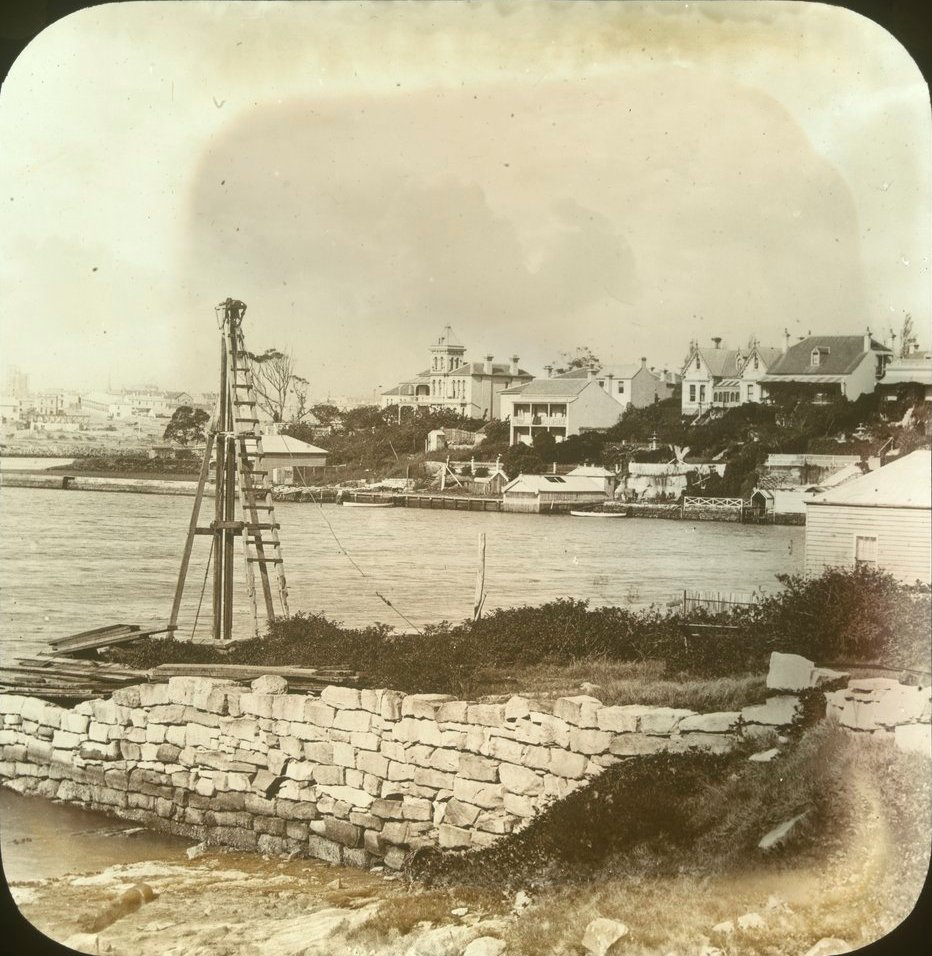
In the 1880s a waterman Richard Suggate, his closest neighbour being George Wells in Bayview, was living between the steam ferry jetty and Whatley’s Wharf, - Glebe: http://bulletin.glebesociety.org.au/2012_05.pdf
GLEBE SCHOOL OF ARTS. A PUBLIC meeting of the inhabitants of the Glebe was hold last evening at the University Hotel, corner of the Glebe and Parramatta roads About itrtj persons were present and Mr. J. Campbell, .... President of the Institution, was called to the chair. The CHAIRMAN, in opening the proceedings, said they were met for the purpose of seeing if they could get their Institution Into good working order In doing this he would be most happy to give all the assistance in his power. GLEBE SCHOOL OF ARTS. (1860, October 16). The Sydney Morning Herald (NSW : 1842 - 1954), p. 5. Retrieved from http://nla.gov.au/nla.news-article13047261
Glebe School of Arts. Also see: dictionaryofsydney.org/entry/glebe_school_of_arts_and_literary_institute
The Musical Boom: A FREE FANTASIA,. (1888, November 2).Table Talk (Melbourne, Vic. : 1885 - 1939), p. 9. Retrieved fromhttp://nla.gov.au/nla.news-article146022069
The Musical World. NEW MUSIC. We have received from Messrs. Paling and Co various new musical publications, all of which have been printed in excellent style by G. Roder of Leipzig, whose name is a sufficient guarantee of the excellence of the printing. The list include the following : 1. "The Mona Waltz," with a frontispiece containing the portrait of a lady so handsome that any young gentleman might regard himself fortunate could he secure her as partner for the waltz or for life. The music is simple melodious, and, as it lies well under the hand is easy to play. No. 2. "The Myee Waltz,” dedicated to the Hon. Myee Carrington, and composed by Annie May Summerbelle, is a very pleasing waltz, and, as the composer of it is youthful, other productions of a more elaborate construction may be expected from her pen. A votary of the dance-goddess, in listening to the melodious strains of it, would quite naturally wish for a smooth floor, and an agile and handsome partner. Nos. 3, 4, and 5 : Of these No. 3a phantasy in A minor, by George F. King, is an easy piece of a dreamy character, as a phantas;I ought Co be. No. 4, " Love Light," is a song by the same author; the words of which are by Henry Tarrington, B.A. The poetry is sentimental, and the melody and accompaniment suitable to the words. No. 5, " Naivete," a lively gavotte for the pianoforte is also by Mr. King. The music of the piece is simple, and distinguished by its naivete. No. 6, " The Etham Waltz,”composed by J. C. de S. Mann, is an exceedingly pretty waltz, written respectively in A flat, D flat, and F major. The rhythm is well marked for dancing, and the music otherwise is excellent. The title page contains a beautiful lithograph of what we take to be the mansion of Mrs. Mitchell, the lady to whom the waltz is dedicated. No. 7, " La Serenata," by Braga, arranged for the pianoforte by Henry Latour. A lady distinguished for her skill as a pianist, exclaimed as she rose from the piano after playing this piece, " It is very beautiful and well arranged ;" and, after due consideration, we fully endorse her criticism. The Musical World. (1891, February 14). Australian Town and Country Journal (Sydney, NSW : 1870 - 1907), p. 28. Retrieved from http://nla.gov.au/nla.news-article71249301
NEW MUSIC.-Mr. G. de Cairos Rego, of Marrickville, professor of music, has composed for the pianoforte a lively dance which he terms "Lilian's Dance," and which is obtainable from all music sellers. The music is written in the keys of C and G, and in two-four time; It is pretty, melodious, and nicely harmonised, and has been beautifully printed by Roder, of Leipzig. As a piquant and pleasant piece for the "drawing-room rather than the ballroom, it is likely to command an extensive sale. The Musical World. (1893, May 6).Australian Town and Country Journal (Sydney, NSW : 1870 - 1907), p. 25. Retrieved from http://nla.gov.au/nla.news-article71198704
DEPARTURE OF LORD AND LADY CARRINGTON FOR ENGLAND. On Wednesday afternoon, November 5, the Governor of New South Wales (Lord Carrington) and Lady Carrington and family arrived in Adelaide by special train from Melbourne, and later in the afternoon they boarded the Orient steamer Orizaba, sailing for London. DEPARTURE OF LORD AND LADY CARRINGTON FOR ENGLAND. (1890, November 8). Adelaide Observer (SA : 1843 - 1904), p. 33. Retrieved from http://nla.gov.au/nla.news-article159554948
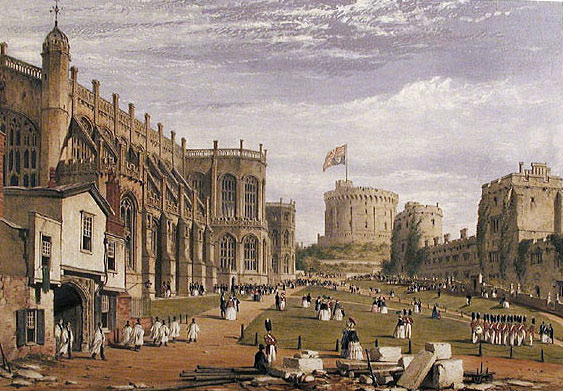
FUNERALS. THE FRIENDS of the late Mrs. MARY GODDARD are respectfully invited to attend her Funeral ; to move from the residence of her son-in-law, Mr. John Bird,23, Glebe-street, off Bay-street, Glebe, THIS (Tuesday) AFTERNOON, at a quarter to 3 o'clock, and proceed to St. Barnabas Church ; from thence to Camperdown Cemetery.
THE FRIENDS of Mr. JOHN GODDARD are respectfully invited to attend the Funeral of his late deceased MOTHER, Mary ; to move from No. 23, Glebe-street, Glebe, off Bay-street, THIS (Tuesday) AFTER-NOON, at a quarter to 3 o'clock, for the Camperdown Cemetery. J. and G. SHYING and CO., 719, George-st.
THE FRIENDS of Mr. HENRY GODDARD are respectfully invited to attend the Funeral of his late deceased MOTHER, Mary ; to move from No. 23, Glebe- street, Glebe, off Bay-street, THIS (Tuesday) AFTER-NOON, at a quarter to 3 o'clock, for the Camperdown Cemetery. J. and G. SHYING and CO., 719, George-st.
THE FRIENDS of Mr. G. WELLS are respectfully invited to attend the Funeral of his late deceased MOTHER-IN-LAW, the late Mrs. Mary Goddard ; to move from No. 23, Glebe-street, Glebe, off Bay-street, THIS (Tuesday) AFTERNOON, at a quarter to 3 o'clock, for the Camperdown Cemetery. J. and G. SHYING and CO.
THE FRIENDS of Mr. JOHN BIRD are respectfully invited to attend the Funeral of his late deceased MOTHER-IN-LAW (the late Mrs. Mary Goddard) ; to move from his residence, No. 23, Glebe-street, Glebe, off Bay-street, THIS (Tuesday) AFTERNOON, at a quarter to 3 o'clock, for the Camperdown Cemetery. J. and G. SHYING and CO., 719, George-street.
THE FRIENDS of Mr. ROBERT STEVENS are respectfully invited to attend the Funeral of his late deceased Mother-in-Law (the late Mrs. Mary Goddard) ; to move from No. 23, Glebe-street, Glebe, off Bay-street, This (Tuesday) Afternoon, at a quarter to 3 o'clock, for the Camperdown Cemetery. J. and G. Shying and Co., Geo.-st. Family Notices. (1874, January 6). The Sydney Morning Herald(NSW : 1842 - 1954), p. 8. Retrieved from http://nla.gov.au/nla.news-article13329484
12. GLEBE. A BRICK BUILT COTTAGE, situate and being No. 23, GLEBE-STREET, the LAND has a frontage of 33 feet by a depth of 214 feet. Advertising. (1883, November 24). The Sydney Morning Herald(NSW : 1842 - 1954), p. 15. Retrieved fromhttp://nla.gov.au/nla.news-article28372536
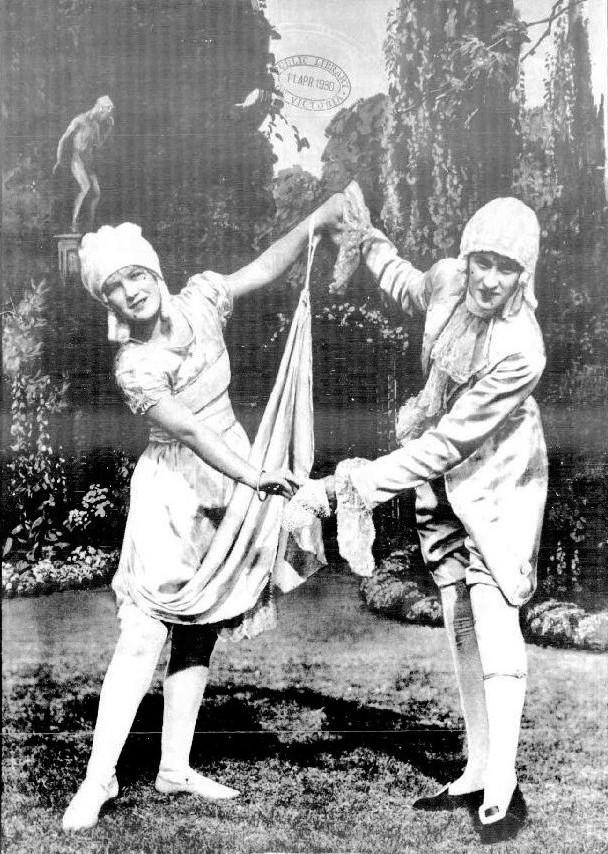
THE FRENCH GAVOTTE. Miss Grace McNamara (left) and Miss Alma Warneke (right), of Melbourne. THE FRENCH GAVOTTE. (1930, April 12). The Australasian(Melbourne, Vic. : 1864 - 1946), p. 61 Edition: METROPOLITAN EDITION. Retrieved fromhttp://nla.gov.au/nla.news-article141429222
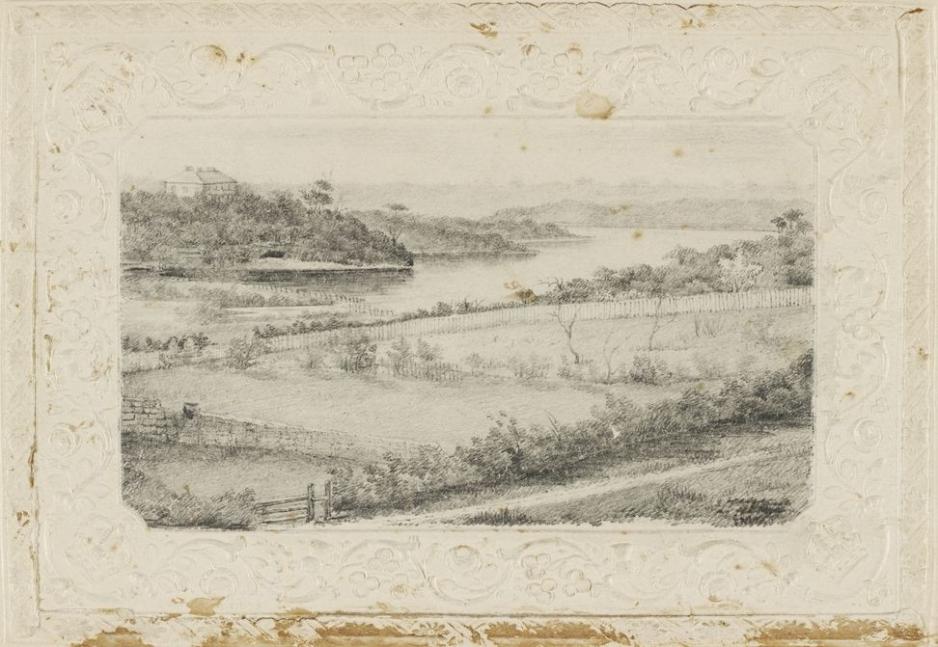
View of Blackwattle Bay (Ultimo Bay then)from Ultimo House 1837: 'View from my room window, 1837' by Emily Manning from Ultimo House. Courtesy State Library of NSW. Image No.: a1528067
Previous Collectors Corner pages:
Blacksmiths and Tinsmiths Nylon Stockings Poster Art Furphy's Water Cart Mousehole Anvil Sapphire One Armed Bandit Gould's 1840 Single and Compound Microscope Tibetan Thangka Wheel Of Life Painting Cast Iron Seats Mabel Lucie Atwell Prints The Customs of Traditional Dining by Hans and Jenny Carlborg Albert Collins Landscape Boomerang Harmonicas Drinking: 18th Century Style Part I by H&J Carlborg Drinking 18th Century Style Part II by H&J Carlborg Fleece Shears Wood Case Crank Telephone 1803 Timepeice Vintage Guitars Milestones No.38RollsRoyceMotorOiler Christmas Postcards Seashells McCormick-Deering Horse Drawn Mower Rope Making Machine Marilyn Monroe 1955 Calendar Stubbie Holders Hill's Hoist Akubra Hat Fowler's Bottling Kit The Bold Autographed Script Fishing Tackle Arnotts Biscuit Tins Comic Books Silver Opium Pipe Mrs Beetons Book Souvenir Teaspoons Bendigo Pottery Gianelli Figurines Key Fobs Model Aircraft-static Porcelain Slippers Wagon Wheels Rhys Williams Painting Chinese Guardian Lions Australian Halfpenny Bud Vases Rolling Stones Still Life LP Autographed WL1895 Thinking Monkey Estee Lauder Ginger Jar Reel Mowers Surf Reels Millers Car Collection Hilton Lingerie - Slips Miniature Books of Verse - A Romantic Tradition REGA Pouring Can R O Dunlop - Sailing At Itchenor Painting Morning Shadows by C Dudley Wood The Father of Santa Claus - Xmas 2012 HMS Penguin Anchor at RPAYC - Newport SS Birubi Mast at RMYC - Broken Bay Helen B Stirling Ship's Wheel at Club Palm Beach Woomeras HMS Endeavour Replica Cannon at RPAYC The Doug Crane Classic Handmade Double Blade Paddle HMS BountyWooden Ship Model Collecting Ladies - Ferdinand Von Mueller and Women Botanical Artists Australian Bark Art Chinese Ginger Jars Hand Plough and Jump Stump Plough - Australian Inventions Frank Clune Books Frederick Metters - Stoves, Windmills, Iron Monger Trinket Boxes 1933 Wormald Simplex Fire Extinguisher is Pure Brass Chapman 'Pup' Maine Engines - Chapman and Sherack The Beach Ball Figureheads – Salty Wooden Personifications of Vessels Binnacle at RMYC The Australian Florin - Worth More Than 20 Cents to Collectors Weathervanes; For Those Passionate About Seeing Which Way the Wind Blows Her Majesty’s Theatre 1962 Programme - Luisillo and his Spanish Dance Theatre Cooper's Sheep Shower Enamel Sign and Simpso's and Sons of Adelaide Jolly Drover Sugar Bowl and English Pottery – A Means to Gaze into the Past Chief Joseph and Edward S Curtis; His Remarkable Images of Native Americans – an Inestimable Record of Images and Portrait Photographs His Masters Voice, Old 78’s and Australia’s Love of Music Jack Spurlings 'Tamar' Picture 1923 Resch's Beer Art - A Reflection of Australiana Now Worth Thousands The Compleat Angler - Izaak Walton’s Discourse Inspires Generations of Fishers Portable Ice-Boxes and Coolers – How Many Claim This Invention as Theirs? Malley's and Sons Ltd. - A Munificent Australian Family Company Vintage Paddles and Gigs – Nautical Memorabilia
by A J Guesdon, 2015.